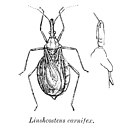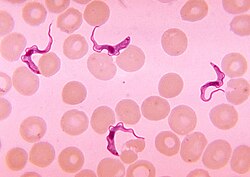The members of the Triatominae /traɪ.əˈtɒmɪniː/, a subfamily of the Reduviidae, are also known as conenose bugs, kissing bugs (so-called from their habit...
21 KB (2,378 words) - 16:25, 23 May 2025
non-predatory Reduviidae are some blood-sucking ectoparasites in the subfamily Triatominae, with a few species from South America noted for their ability to transmit...
17 KB (1,746 words) - 06:39, 25 May 2025
of assassin bug in the subfamily Triatominae (kissing bugs). The members of Triatoma (like all members of Triatominae) are blood-sucking insects that can...
9 KB (755 words) - 10:38, 11 January 2025
a blood-sucking bug (like virtually all the members of its subfamily Triatominae) and the most important vector of Trypanosoma cruzi which can lead to...
12 KB (1,215 words) - 21:22, 9 March 2025
Triatominae (the kissing bugs). It is the only genus of Triatomines restricted to the Old World within the mostly Neotropical subfamily Triatominae (a...
6 KB (674 words) - 14:07, 31 October 2024
Triatoma dominicana is an extinct species of assassin bug in the subfamily Triatominae, the kissing bugs known from early Miocene Burdigalian stage Dominican...
4 KB (379 words) - 19:40, 28 September 2024
metaxytaxa is a species of fossil insect belonging to the subfamily Triatominae (kissing bugs) of the family Reduviidae. Living kissing bugs are blood-sucking...
7 KB (765 words) - 20:46, 26 May 2025
Rhodnius is a genus of assassin bugs in the subfamily Triatominae (the kissing bugs), and is an important vector in the spread of Chagas disease. The...
5 KB (400 words) - 13:36, 6 December 2023
Parabelminus is a genus of bugs in the subfamily Triatominae. The species of this genus could be found in Brazil, specially in Rio de Janeiro and Bahia...
2 KB (147 words) - 01:03, 28 May 2025
also known as the eastern bloodsucking conenose, is an insect of the Triatominae subfamily, known as kissing bugs. It was first described by John Lawrence...
6 KB (633 words) - 12:20, 29 August 2024
Mepraia is a genus in the subfamily Triatominae, endemic in Chile, and vectors of Chagas disease. Source: Mepraia eratyrusiformis (Del Ponte, 1929) Mepraia...
1 KB (106 words) - 20:13, 24 January 2025
family Pentatomidae. In Chile, it has been confused with kissing bugs (Triatominae), causing unjustified alarm. The average length is 16–20 millimetres...
13 KB (1,487 words) - 08:42, 8 March 2025
Panama and northern South America. Like other members of the subfamily Triatominae, Cavernicola species primarily feed on vertebrate blood. Like other members...
2 KB (165 words) - 01:26, 4 May 2024
Relationships of the Triatoma sordida subcomplex (Hemiptera: Reduviidae: Triatominae)". Acta Tropica. 212. doi:10.1016/j.actatropica.2020.105679. hdl:11449/202057...
14 KB (1,559 words) - 05:20, 2 June 2025
Alberproseniini Martínez & Carcavallo, 1977 belongs to the subfamily Triatominae and only has one genus, Alberprosenia Martínez & Carcavallo, 1977, with...
1 KB (94 words) - 19:41, 15 January 2023
Panstrongylus megistus is a blood-drinking insect in the subfamily Triatominae. It is found in the Guianas, Brazil, Bolivia, Paraguay, Uruguay and Argentina...
5 KB (464 words) - 17:06, 6 January 2024
A., et al. (2012). The biology of three Mexican-American species of Triatominae (Hemiptera: Reduviidae): Triatoma recurva, Triatoma protracta and Triatoma...
3 KB (301 words) - 22:11, 13 March 2025
allows a triatominae, a vector of the flagellate, to take a blood meal from the patient. The doctor later inspects the gut of the triatominae for growth...
2 KB (241 words) - 03:07, 17 February 2025
Chagas' disease vector in northeastern Brazil (hemiptera, reduviidae, triatominae)". Am J Trop Med Hyg. 67 (5): 516–20. doi:10.4269/ajtmh.2002.67.516....
6 KB (640 words) - 17:13, 5 January 2024
Poinar, G. (2005). "Triatoma dominicana sp. n. (Hemiptera: Reduviidae: Triatominae), and Trypanosoma antiquus sp. n. (Stercoraria: Trypanosomatidae), the...
68 KB (6,827 words) - 21:03, 29 May 2025
Microtriatoma is a genus of bugs that belongs to the subfamily Triatominae. This genus has two known species: M. borbai (Lent & Wygodzinsky, 1979 (Tc))...
1 KB (103 words) - 14:05, 31 October 2024
Dipetalogaster, a genus of Triatominae, the kissing bugs, has only a single species, Dipetalogaster maxima (often misspelled as "maximus", e.g.), which...
5 KB (497 words) - 01:46, 11 September 2023
Eratyrus is a genus of insects belonging to the assassin bug subfamily Triatominae. This genus has a wide distribution throughout central and northern South...
1 KB (113 words) - 21:58, 20 January 2024
(Hemiptera, Triatominae) en el estado brasileño de "Rio Grande do Sul"" [Finding of Triatoma platensis Neiva, 1913 (Hemiptera, Triatominae) in the Brazilian...
2 KB (181 words) - 16:18, 30 November 2024
Panstrongylus is a genus of insects that belongs to the subfamily Triatominae. Its members are found from Mexico into South America. Panstrongylus chinai...
4 KB (365 words) - 00:31, 24 May 2025
stinging or biting insects such as Hymenoptera (ants, bees, and wasps) or Triatominae (kissing bugs) may cause anaphylaxis in susceptible people. Previous...
58 KB (6,224 words) - 08:34, 24 May 2025
Cervantesperedo, Fredy S. Mendoza-Palmero, and Sergio Ibáñez-Bernal. "The Triatominae (Hemiptera: Heteroptera: Reduviidae) of Veracruz, Mexico: Geographic...
9 KB (1,150 words) - 07:01, 4 February 2023
The genus Psammolestes belongs to the subfamily Triatominae. It can be found in the nests of various birds, mainly in the family Furnariidae. 3 species:...
1 KB (107 words) - 05:03, 5 February 2024
hills (300 to 1700 m above sea level). As all members of the subfamily Triatominae, T. nigromaculata is a blood-sucking bug and a potential vector of Chagas...
3 KB (304 words) - 21:20, 22 December 2022
trypanosomes passed to the recipient in the feces of insects from the subfamily Triatominae (most importantly Triatoma infestans). This group includes Trypanosoma...
20 KB (2,118 words) - 20:00, 24 May 2025




















